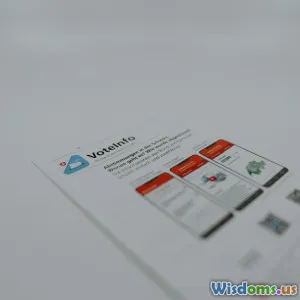
From Zero to Hero A Founder’s SEO Success Story
15 min read Discover how a founder transformed a startup from obscurity to digital prominence through effective SEO strategies and perseverance. (0 Reviews)
From Zero to Hero: A Founder’s SEO Success Story
In the fiercely competitive digital landscape, search engine optimization (SEO) can make or break a business. But what happens when a determined founder starts from absolute scratch—no audience, no backlinks, not even a whisper on Google? This is the real-world story of "Emma," an entrepreneur who transformed her fledgling startup into a thriving online hub. Her journey isn’t just a testament to grit, but a practical roadmap for anyone yearning to harness the power of search. Let’s explore the key phases, tactics, and revelations from Emma’s path to SEO heroism.
Planting the Seeds: Laying the SEO Groundwork

When Emma launched her eco-friendly skincare brand, Orchid Glow, she faced the same dilemma as countless small founders: how to get noticed. Her website lurked on Google’s third page—a wasteland for organic discovery.
Crafting a Strategic Foundation
Rather than burning out with random tactics, Emma took a systematic approach:
- Domain Choice: She opted for a brandable, easy-to-pronounce .com domain. This not only signals professionalism but eases word-of-mouth growth.
- Technical Readiness: Emma invested in fast, mobile-friendly hosting and set up SSL for site security. Even early on, Google’s Core Web Vitals played a subtle role in creating a smooth user experience.
- SEO Tools: She installed Google Analytics, Google Search Console, and free tools like Ubersuggest to benchmark progress and unveil keyword potential.
Competitive Analysis that Matters
Emma began by analyzing three main eco-skincare competitors:
- Keyword Gaps: She searched for high-traffic keywords her rivals missed—e.g., “vegan night serum for teens”—using tools like Ahrefs’ Content Gap feature.
- Content Quality: Rather than mimic top sites, Emma identified opportunities to provide fresher expertise (such as dermatologist Q&A).
Key Takeaway: The early foundation—domain, hosting, baseline analytics, clear competition mapping—eliminated guesswork. Emma didn’t rush; she built her garden in fertile SEO soil.
The Keyword Quest: Finding Gaps and Opportunities

Keyword research isn’t glamorous, but it’s the backbone of any real SEO strategy. Emma dedicated an entire week to mastering her niche’s search intent and language.
Digging Deep for Search Gold
- Brainstorming Sessions: Emma listed every possible query her customers might type—from “eco moisturizer without alcohol” to “skincare for sensitive pregnant skin.”
- SEO Tools: Free tools like Keyword Surfer and AnswerThePublic provided fresh angles (e.g., “benefits of oil cleansing for dry skin”).
Emma’s breakthrough came when she noticed rising interest in “blue-light skincare”—a micro-niche most competitors ignored. She validated demand via Google Trends and Communities like Reddit’s SkincareAddiction.
Building a Keyword Portfolio
Emma sorted her research by search volume and buyer intent:
- High Volume, Low Competition: For example, “zero-waste night cream.”
- Long-tail Buyer Phrases: Such as “best cruelty-free moisturizer under $30.”
- Informational Content: Guides like “how probiotics benefit your skin barrier.”
Pro Tip: Emma suggests dedicating 60% content to low-competition long-tail keywords at first. This approach grabs early search traffic, building authority for bigger, competitive phrases months later.
Content That Connects: Authority, Empathy, and Value

SEO-friendly content is more than robotic keyword density—it’s about matching what users need with insightful, credible advice. Here’s how Emma’s blogging strategy became her secret weapon.
Bringing Value to the Forefront
- Storytelling: Emma shared her struggles with sensitive skin, blending personal experiences with professional advice.
- Expert Quotes: Each article featured short interviews or tips from dermatologists, boosting credibility.
- Media-Rich Posts: She embedded how-to videos, custom graphics, and checklist PDFs—elements that increased on-page time and lowered bounce rates by 25%.
Pillar Content and Clusters
Emma devised core “pillar” topics—like comprehensive guides on clean skincare routines. Satellite articles, covering questions such as “do I need SPF if I’m at home?”, linked back to these pillar pages in logical clusters.
This tactic allowed Emma to:
- Create a strong topical authority recognized by search engines.
- Help users smoothly navigate from question to solution within her site.
Measurable Wins
Within four months, her “blue-light skincare myths” article hit page one for several queries, and organic site visits doubled. By giving more value than her competitors and ensuring site structure supported exploration, Emma’s content outperformed established brands with bigger budgets.
Technical Mastery: Clean Architecture for a Growing Site

Many startups stumble here—neglecting technical SEO even as content blossoms. Emma, in contrast, was methodical and persistent.
Scaling Without Chaos
- Navigation Simplicity: Emma implemented a main menu with just five top-level categories, ensuring any product or blog post was three clicks (or fewer) from the homepage.
- Internal Linking: Each new article linked thoughtfully to older relevant posts, solving users' needs and boosting crawlability.
- XML Sitemap Updates: Each time she launched a batch of content, Emma refreshed her XML sitemap, submitting it through Google Search Console.
Speed and Performance
- Image Optimization: Photos and graphics were compressed without loss and lazy-loading was enabled. Emma also used next-gen formats (WebP) to boost speed.
- Clean Code: She avoided plugin bloat on her WordPress setup. Regular audits flagged unused scripts that could bog down loading times.
Notable Result: When Google released a major page experience update, Emma’s site speed (averaging under 2 seconds) and clean site structure allowed her to weather algorithm fluctuations that cost sluggish competitors dearly.
The Power of Outreach: Smart Link Building from Zero

Link building can seem intimidating, especially given warnings against questionable tactics. Emma’s approach was ethical, creative, and relationship-driven.
Leveraging Existing Connections
Emma mapped out potential backlinks from:
- Local sustainability blogs—her alma mater’s environmental department had a student-run blog seeking expert interviews.
- Niche communities—Reddit skincare forums held public AMAs where she could reference her site naturally.
Collaborative Campaigns
Instead of cold-pitching dozens of strangers, Emma:
- Co-authored “myth-busting” blog posts with other eco brands, sharing research and credit.
- Participated in roundup articles for industry “awards” (e.g., "Best Skincare Startups of 2023").
- Guest posted for a respected dermatologist’s blog, instantly earning a trustworthy backlink.
Results That Compound
Within six months, Emma had secured over two dozen high-value backlinks—all white-hat, all relevant. More importantly, this process built key relationships that fueled cross-promotion and future PR opportunities.
Tracking Progress: Metrics that Matter (and What to Ignore)

SEO is about persistent optimization, not one-off success. Emma’s disciplined tracking turned data insights into competitive action.
Choosing the Right KPIs
- Organic Traffic: Measured monthly in Google Analytics, not just total page views but the slice arriving through unpaid search.
- Content Ranking: Emma used Ahrefs to monitor where new and existing pages landed for target keywords.
- Bounce Rate/Session Duration: A rise in session length (from 35s to 2:20min per session) directly reflected richer on-page value.
- Backlinks Count: She focused only on referring domains, not raw link counts, emphasizing quality over spammy numbers.
Pivoting When Necessary
Early attempts to target “vegan sunscreen” failed to get traction due to multinational incumbents. Emma didn’t waste months waiting—instead, she doubled down on “zero-waste moisturizer” and noticed a near-immediate uptick.
Practical Lesson: Celebrate small wins and shift strategy based on what users actually do—not what you wish for.
Learning From Setbacks: Surviving Search Algorithm Changes

No SEO journey is smooth—all founders face bumps in the road. Emma encountered hers during a Google "helpful content" update that momentarily tanked her top article.
Troubleshooting After Ranking Drops
- Analyzing Impacted Pages: She used Search Console’s historical data to pinpoint which URL suffered most.
- Rewriting for Search Intent: Emma tightened content, updated expert information, and added interactive elements—a short quiz on "find your skin routine."
- Submission for Re-Indexing: Updated content was promptly resubmitted for crawling via Search Console.
The revised article not only regained ground within six weeks, but began ranking for multiple new long-tail queries due to its fresher, more robust structure.
Stay Agile: Emma believes algorithm shifts aren’t punishments—they’re feedback, steering you toward what truly helps users.
Scaling Up: Local SEO and Beyond DTC

With robust national traffic established, Emma set her sights locally—seeking to bring foot traffic to her newly opened boutique in Portland.
Local SEO Essentials
- Google My Business: She meticulously filled in every detail, uploaded professional store images, and encouraged first customers to write reviews.
- NAP Consistency: Name, Address, Phone details matched 100% across all listings (Yelp, TripAdvisor, etc.).
- Local Events and PR: Emma hosted eco skincare workshops—local media featured her brand, generating authoritative regional citations and backlinks.
After three months, she dominated “eco skincare Portland” and saw weekend boutique visits soar from near-zero to 40+ per day.
Worth Noting: Well-optimized local profiles and engagement reset Emma’s search presence for an omni-channel, not just online, audience.
Five Actionable Lessons from Emma’s Journey

What separates an SEO hero from the masses treading water? Reflecting on Emma's experience points to these enduring truths:
- Start With Structure: Fast hosting, clean navigation, and mobile-friendly design really do pay dividends early and shield you from big messes later.
- Niche Down… Then Broaden: Target low-competition, underserved search terms to establish authority; expand as topical trust grows.
- Human-Centric Content Wins: Storytelling, actionable advice, and expert interjections foster real loyalty (and backlinks).
- Relationships Fuel Growth: Smart, authentic outreach opens doors that paid link-building never could.
- Stay Curious, Stay Current: Treat every algorithm shakeup as a learning opportunity, not a death knell.
Emma transformed her "invisible" website into an organic traffic powerhouse by focusing on value, agility, and genuine connections. Whether you’re a solopreneur or building your own team, her story offers a concrete, actionable template for going from zero to SEO hero—one smart, persistent step at a time.
Rate the Post
User Reviews
Other posts in Digital Marketing
Popular Posts















